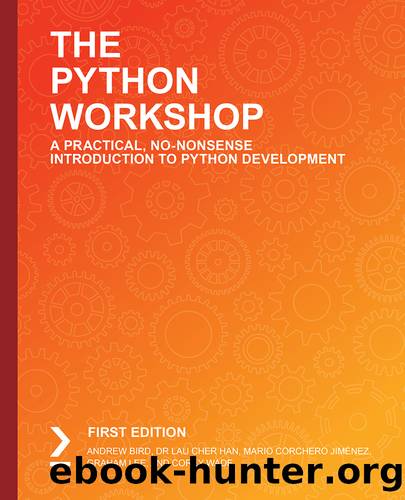The Python Workshop by Bird Dr Lau Cher Han Mario Corchero Jiménez Graham Lee and Corey Wade

Author:Bird, Dr Lau Cher Han, Mario Corchero Jiménez, Graham Lee, and Corey Wade
Language: eng
Format: epub
Publisher: Packt Publishing Pvt Ltd
Published: 2019-11-04T00:00:00+00:00
Configuring the Logging Stack
Another part of the logging library is the functions to configure it, but before diving into how to configure the logging stack, you should understand its different parts and the role they play.
You've already seen logger objects, which are used to define the logging messages that need to be generated. There are also the following classes, which take care of the process of processing and emitting a log:
Log Records: This is the object that is generated by the logger and contains all the information about the log, including the line where it was logged, the level, the template, and arguments, among others.
Formatters: These take log records and transform them into strings that can be used by handlers that output to streams.
Handlers: These are the ones that actually emit the records. They frequently use a formatter to transform records into strings. The standard library comes with multiple handlers to emit log records into stdout, stderr, files, sockets, and so on.
Filters: Tools to fine-tune log record mechanisms. They can be added to both handlers and loggers.
Download
This site does not store any files on its server. We only index and link to content provided by other sites. Please contact the content providers to delete copyright contents if any and email us, we'll remove relevant links or contents immediately.
| Coding Theory | Localization |
| Logic | Object-Oriented Design |
| Performance Optimization | Quality Control |
| Reengineering | Robohelp |
| Software Development | Software Reuse |
| Structured Design | Testing |
| Tools | UML |
The Mikado Method by Ola Ellnestam Daniel Brolund(20604)
Hello! Python by Anthony Briggs(19900)
Secrets of the JavaScript Ninja by John Resig Bear Bibeault(18208)
Dependency Injection in .NET by Mark Seemann(18109)
The Well-Grounded Java Developer by Benjamin J. Evans Martijn Verburg(17576)
OCA Java SE 8 Programmer I Certification Guide by Mala Gupta(17422)
Kotlin in Action by Dmitry Jemerov(17185)
Adobe Camera Raw For Digital Photographers Only by Rob Sheppard(16934)
Algorithms of the Intelligent Web by Haralambos Marmanis;Dmitry Babenko(16237)
Grails in Action by Glen Smith Peter Ledbrook(15390)
Test-Driven iOS Development with Swift 4 by Dominik Hauser(10393)
Becoming a Dynamics 365 Finance and Supply Chain Solution Architect by Brent Dawson(8056)
Microservices with Go by Alexander Shuiskov(7820)
Practical Design Patterns for Java Developers by Miroslav Wengner(7721)
Test Automation Engineering Handbook by Manikandan Sambamurthy(7672)
Angular Projects - Third Edition by Aristeidis Bampakos(7160)
The Art of Crafting User Stories by The Art of Crafting User Stories(6611)
NetSuite for Consultants - Second Edition by Peter Ries(6533)
Demystifying Cryptography with OpenSSL 3.0 by Alexei Khlebnikov(6305)
